
Quercus cerris, the Turkey oak or Austrian oak, is an oak native to south-eastern Europe and Asia Minor. It is the type species of Quercus sect. Cerris, a section of the genus characterised by shoot buds surrounded by soft bristles, bristle-tipped leaf lobes, and acorns that usually mature in 18 months.

Grevillea acanthifolia, commonly known as the Acanthus-leaved grevillea, is a plant in the family Proteaceae and is endemic to New South Wales. It is a shrub with stiff, prickly, divided leaves and pink to purple "toothbrush" flowers.
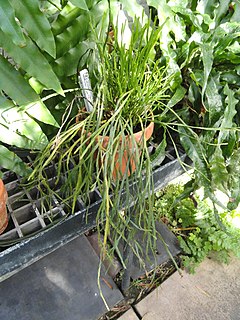
Psilotum complanatum, the flatfork fern, is a rare herbaceous epiphytic fern ally in the genus Psilotum. There is some evidence that it might be a true fern that has lost some typically fern-like characteristics. Morphologically, the plant is simple, lacking leaves and roots, and having hanging stems with dichotomous branching, which lack developed leaves but have minute scales. The stems and branches have protostele, with a triangular-shaped core of xylem. The scales are arranged in two rows along the flat stems and branches. The stems are broadly triangular in cross section and 5 mm wide. The branches are 1.5 to 2 mm wide. P. complanatum grows 10 to 75 cm long and stems branch in pairs a number of times up their length and are covered with brownish colored hair-like rhizoids. Small stalks end with simple sporangia from the axils of minute bifid, rounded sporophylls. Bean shaped, monolete spores are produced. The spores germinate best in a dark environment when ammonium is present. The gametophyte is non-photosynthetic, living in association with a fungus for its nutritional needs. Plants grow from a subterranean rhizome which anchors the plant in place and absorbs nutrients by means of filament like rhizoids.

Liparis, commonly known as widelip orchids, sphinx orchids or 羊耳蒜属 is a cosmopolitan genus of more than 350 species of orchids in the family Orchidaceae. Plants in this genus are terrestrial, lithophytic or epiphytic herbs with a wide range of forms. The flowers are usually resupinate and small to medium sized, yellow, yellow-green or purplish with spreading sepals and petals. The labellum is usually larger than the sepals and petals and is lobed, sometimes with a toothed or wavy margin and one or two calli at its base.

Frangula alnus, commonly known as alder buckthorn, glossy buckthorn, or breaking buckthorn, is a tall deciduous shrub in the family Rhamnaceae. Unlike other "buckthorns", alder buckthorn does not have thorns. It is native to Europe, northernmost Africa, and western Asia, from Ireland and Great Britain north to the 68th parallel in Scandinavia, east to central Siberia and Xinjiang in western China, and south to northern Morocco, Turkey, and the Alborz in Iran and Caucasus Mountains; in the northwest of its range, it is rare and scattered. It is also introduced and naturalised in eastern North America.
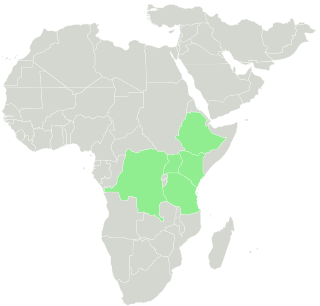
Subularia monticola is one of the water loving, annuals of the genus Subularia in the family Brassicaceae. It lives in the cool, moist high elevations of Ethiopia, Kenya, Tanzania, Uganda and Zaire.

Selaginella selaginoides is a non-flowering plant of the spikemoss genus Selaginella with a wide distribution around the Northern Hemisphere. It resembles a moss in appearance but is a vascular plant belonging to the division Lycopodiophyta. It has a number of common names including lesser clubmoss, club spikemoss, northern spikemoss, low spikemoss and prickly mountain-moss. This plant has one close relative, Selaginella deflexa, native to Hawaii. These two plants form a small clade that is sister to all other Selaginella species.

Thelasis, commonly known as fly orchids, is a genus of flowering plants from the orchid family, Orchidaceae. Plants in this genus are usually epiphytes, sometimes lithophytes or rarely terrestrials. Some species have pseudobulbs with up to three leaves, whilst others have several leaves in two ranks. A large number of small, white or greenish yellow flowers are borne on a thin, arching flowering stem. There are about thirty species, distributed from tropical and subtropical Asia to the southwest Pacific.

Carex binervis, the green-ribbed sedge, is a European species of sedge with an Atlantic distribution. It is found from Fennoscandia to the Iberian Peninsula, and occurs in heaths, moorland and other damp, acidic environments. It typically grows to a height of 15–120 cm (6–50 in), and has inflorescences comprising one male and several female spikes, each up to 45 mm (1.8 in) long. The utricles have two conspicuous green veins, which give rise to both the scientific name and the common name of the species. In the vegetative state, it closely resembles C. bigelowii, a species that usually grows at higher altitude. C. binervis was first described by James Edward Smith in 1800, and is classified in Carex sect. Spirostachyae; several hybrids with other Carex species are known.
Acanthopale pubescens is a species of the genus Acanthopale of the family Acanthaceae. The species occurs in East and Southern Africa. Acanthopale pubescensis also known as Herayye in Ethiopia.

Maesopsis eminii, the umbrella tree, is a species of tree in the family Rhamnaceae found in India and Africa. It is the only species in the genus Maesopsis. It is often grown as a plantation tree, and as a shade tree in coffee plantations and other crops. Birds and monkeys may disperse the seeds. Since this tree grows fast it is often used for regeneration of destroyed forest lands. Its timber is used for construction and firewood and its leaves for animal fodder.

Canarina canariensis is a species of flowering plant in the bellflower family Campanulaceae, commonly known as the Canary Island bellflower, and known locally as bicácaro.
Canarina abyssinica is a dull grey-green plant with fleshy rootstock and triangular, ovate leaves. Its pendulous, solitary flowers 5–6 cm long are orange-red with a five lobed calyx and a large corolla that is tubular or bell-shaped.
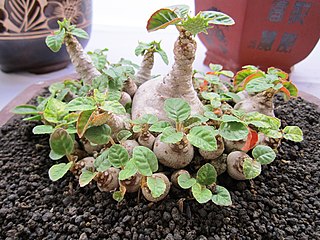
Dorstenia foetida is a succulent plant in the genus Dorstenia, which is native to Eastern Africa and Arabia. It is a very variable species with a wide distribution.
Plectorrhiza erecta , commonly known as the upright tangle orchid, is an epiphytic or lithophytic orchid that has many coarse, cord-like roots, many bright green leaves and up to five yellowish orange, cup-shaped flowers with purplish blotches. It grows close to the ground on fibrous barked plants and only occurs on Lord Howe Island.
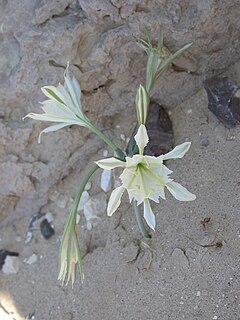
Pancratium sickenbergeri is a species of flowering plant in the Amaryllidaceae family. It is a Saharo-Arabian plant that grows in deserts, such as the Negev. It is native to Israel, Egypt, Lebanon, Palestine, Saudi Arabia, and Syria. The flowers look like the Mediterranean species Pancratium maritimum, but the leaves of P. sickenbergeri are curly and the plant is much smaller. Unusually for the desert, the seeds are distributed by floodwaters when they occur in the winter.
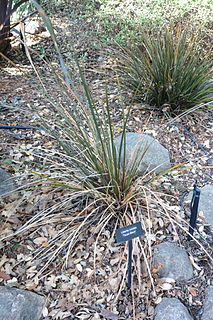
Libertia ixioides is a flowering plant in the family Iridaceae. The species is endemic to New Zealand. It is a rhizome-forming herbaceous perennial. The Latin ixioides means like an ixia, due to its similarities with that plant species.
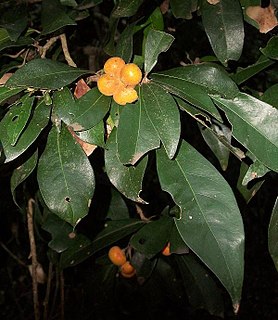
Cola greenwayi, commonly known as hairy cola or Zulu coshwood, is a species of flowering plant in the family Malvaceae. It was first described in 1956 by the English botanist John Patrick Micklethwait Brenan. It is native to southeastern Africa.
Orbivestus karaguensis is a plant in the family Asteraceae, native to Africa.

Symphyotrichum potosinum is a species of flowering plant in the aster family (Asteraceae) native to Mexico and the U.S. state of Arizona. Commonly known as Santa Rita Mountain aster, it is a perennial, herbaceous plant that may reach 15 to 45 centimeters tall.















